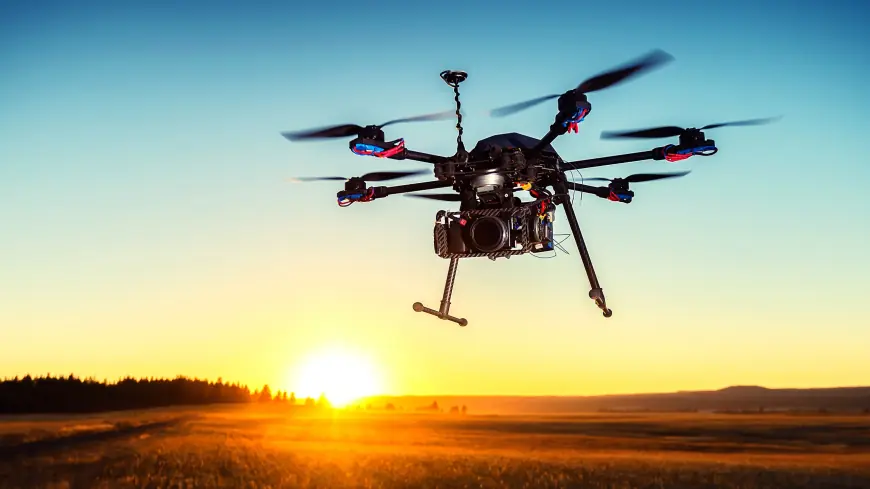Drone Insurance Market 2030 Trends, Opportunities & Analysis
One of the primary drivers of the global drone insurance market is the widespread adoption of drones across various industries.

Introduction
The Global Drone Insurance Market is undergoing rapid expansion as drones transition from niche technological tools to mainstream assets powering industries worldwide. According to industry assessments, the market was valued at USD 1.36 billion in 2023 and is projected to grow at a CAGR of 9.7% during 2025–2029, underscoring the growing necessity of insurance coverage tailored to drone operations.
Unmanned aerial vehicles (UAVs), popularly known as drones, are transforming industries such as agriculture, logistics, construction, defense, mining, and insurance itself. From crop surveillance and parcel delivery to infrastructure inspection and real estate marketing, drones are reshaping operational models. However, their increasing usage has also led to heightened risks of collisions, privacy violations, theft, equipment malfunction, and regulatory breaches, fueling the demand for specialized insurance solutions.
This article provides an in-depth outlook on the Global Drone Insurance Market, exploring its emerging trends, growth drivers, challenges, opportunities, and competitive dynamics, along with insights into its future trajectory.
Market Overview
Drone insurance provides coverage against liabilities and damages associated with drone usage. Traditional insurance models have proven insufficient for UAV-specific risks, prompting insurers to design customized products addressing operational, technological, and legal challenges.
Market expansion is supported by three interdependent factors:
- Rising drone adoption across industries for commercial and personal use.
- Growing incidents and operational risks necessitating insurance protection.
- Evolving regulatory frameworks requiring compliance through liability coverage.
As a result, insurers are no longer offering basic liability coverage alone but are diversifying into hull damage, theft coverage, payload insurance, cyber liability, and business interruption protection, making drone insurance a multidimensional financial safeguard.
Download Free Sample Report: https://www.techsciresearch.com/sample-report.aspx?cid=23381
Emerging Trends in the Global Drone Insurance Market
1. Customized and On-Demand Insurance Solutions
Traditional one-size-fits-all insurance is giving way to on-demand and customized policies. Drone operators can now purchase hourly or mission-based coverage for specific flights. This flexibility reduces costs for businesses and hobbyists who do not operate drones full-time.
2. Expansion Beyond Liability Coverage
Earlier, most policies focused only on third-party liability. Today, insurers are including comprehensive plans covering drone theft, loss during flight, cyberattacks on drone systems, and damage to payloads such as cameras and sensors.
3. Integration of Artificial Intelligence and Data Analytics
AI and big data analytics are revolutionizing underwriting processes. Insurers use flight data, weather analytics, and operational history to assess risks more accurately. Predictive analytics helps insurers calculate premiums while reducing fraud and claims processing time.
4. Partnerships Between Insurers and Drone Manufacturers
Collaborations between insurance providers, UAV manufacturers, and software developers are rising. These partnerships ensure seamless policy integration into drones at the point of purchase, offering buyers hassle-free coverage activation.
5. Rise of Cyber Liability Insurance
As drones increasingly rely on GPS and connectivity, cyber risks have surged. Cyber liability coverage is emerging as a crucial trend, protecting operators against hacking, data breaches, and remote hijacking attempts.
Key Market Drivers
1. Growing Drone Adoption Across Industries
The commercial drone ecosystem is expanding rapidly. Agriculture uses drones for precision farming, logistics companies experiment with last-mile delivery, and construction firms employ UAVs for surveying. This widespread adoption drives consistent demand for insurance to safeguard assets and ensure compliance.
2. Increasing Frequency of Drone-Related Incidents
Collisions with aircraft, property damage, equipment malfunction, and privacy intrusions have heightened awareness of potential liabilities. Businesses and regulators now view insurance as a mandatory risk management tool rather than an optional investment.
3. Evolving Regulatory Frameworks
Government agencies such as the FAA (United States) and EASA (Europe) enforce drone operation regulations that often mandate liability coverage. This compliance-driven demand is a primary growth driver for the global drone insurance market.
4. Rising Investments in Drone Technology
With drones becoming more advanced, operators are handling high-value assets like LiDAR sensors, thermal cameras, and heavy-duty payloads. Protecting these expensive instruments through insurance coverage has become essential.
5. Business Continuity and Risk Mitigation
For businesses using drones in critical operations, insurance coverage ensures financial protection from unforeseen accidents. Liability and hull coverage protect not just equipment but also business reputation and operational continuity.
Industry Key Highlights
- The Global Drone Insurance Market was valued at USD 1.36 billion in 2023, expected to grow at 9.7% CAGR through 2029.
- Commercial drone usage is a primary contributor, with agriculture, construction, and logistics leading adoption.
- Liability coverage remains dominant, though hull damage, cyber liability, and theft coverage are gaining traction.
- North America leads the market, driven by robust FAA regulations and widespread drone adoption.
- AI-powered risk assessment and on-demand policy models are transforming the industry landscape.
Competitive Analysis
The competitive landscape of the drone insurance market is defined by specialized providers, tech-driven insurers, and global insurance giants expanding their UAV coverage portfolios. Companies are focusing on product innovation, partnerships, and technology integration to gain an edge.
Major Players:
- Thimble Insurance – Known for flexible on-demand drone policies.
- Avion Insurance – Specializes in aviation-related insurance including UAVs.
- REIN – Leverages data-driven platforms for customized drone coverage.
- Coverdrone – Offers global drone coverage with strong presence in Europe.
- Driessen Assuradeuren – Provides niche insurance solutions for UAV operators.
- Embroker – A digital-first insurer offering tailored drone policies.
- Moonrock Insurance – Specializes in commercial drone fleet insurance.
- Global Aerospace – A global leader in aviation insurance expanding into drones.
- Towergate – Focuses on comprehensive liability and hull coverage.
Competitive Strategy Insights:
- Companies are emphasizing digital platforms for policy issuance and claims.
- Collaboration with UAV manufacturers is enhancing integrated offerings.
- Cyber liability insurance is becoming a differentiator among players.
- Expansion into emerging markets such as Asia-Pacific is gaining momentum.
Future Outlook
The future of the Global Drone Insurance Market looks promising, underpinned by rapid UAV adoption, ongoing regulatory developments, and increasing risk complexity. Key trends expected to shape the market include:
- AI-Driven Premiums: Real-time flight monitoring and data-driven analytics will make insurance pricing more accurate.
- Integration with Drone-as-a-Service (DaaS): As businesses outsource drone operations, bundled insurance packages will rise.
- Growth in Cyber Coverage: With drones increasingly connected to IoT networks, demand for cyber risk protection will escalate.
- Emergence of Parametric Insurance: Policies triggered by measurable data, such as weather conditions, may gain traction.
- Global Expansion: Asia-Pacific, particularly China and India, will witness strong demand due to increasing drone usage in agriculture and surveillance.
By 2029, drone insurance will not only be a compliance requirement but also a strategic enabler, ensuring operational safety, risk management, and financial protection for industries relying on UAVs.
10 Benefits of the Research Report
- Provides comprehensive market size, share, and growth projections.
- Offers insights into emerging industry trends and technologies.
- Identifies key growth drivers and challenges shaping the market.
- Breaks down segmentation by coverage type, pricing, and applications.
- Delivers regional insights highlighting opportunities in major geographies.
- Offers detailed competitive analysis with profiles of leading players.
- Evaluates future growth potential with reliable forecasting models.
- Helps businesses identify investment opportunities and risks.
- Supports strategic decision-making for insurers, investors, and drone operators.
- Provides a roadmap for sustainable market entry and expansion strategies.
Conclusion
The Global Drone Insurance Market is set on a growth trajectory fueled by drone proliferation across industries, rising incident risks, and regulatory compliance. Insurance is no longer viewed as optional but as a critical enabler of safe and sustainable drone operations. With innovations such as on-demand coverage, AI-driven risk modeling, and cyber liability protection, insurers are adapting to the complexities of UAV operations.
North America continues to dominate, while Asia-Pacific emerges as a fast-growing region with tremendous untapped potential. The competitive landscape is vibrant, with insurers differentiating through digital platforms, specialized products, and strategic collaborations.
Looking ahead, the industry will witness transformative opportunities, from parametric insurance to embedded policies within drones. As drones evolve from recreational tools to indispensable industrial assets, drone insurance will become the cornerstone of risk management and business continuity worldwide.
Contact Us-
Mr. Ken Mathews
708 Third Avenue,
Manhattan, NY,
New York – 10017
Tel: +1-646-360-1656
Email: [email protected]
Website: www.techsciresearch.com
What's Your Reaction?
 Like
0
Like
0
 Dislike
0
Dislike
0
 Love
0
Love
0
 Funny
0
Funny
0
 Angry
0
Angry
0
 Sad
0
Sad
0
 Wow
0
Wow
0

















































